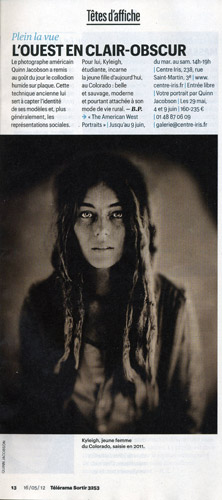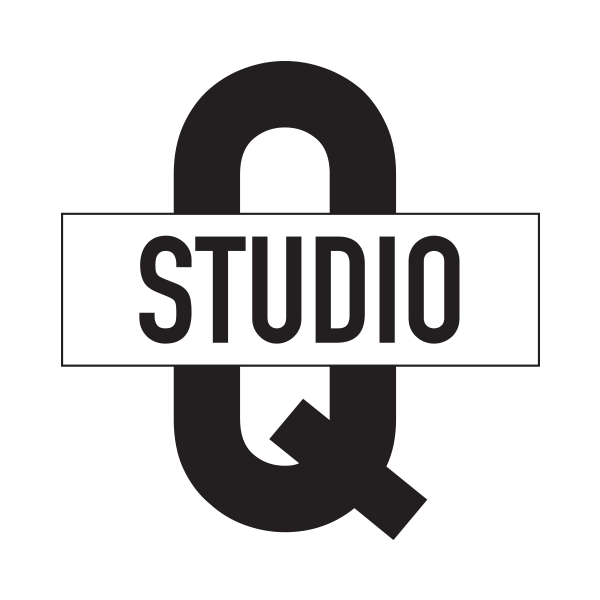Paris, France
It’s five o’clock in the morning. I woke up at four o’clock this morning. I flew into Denver late last night from Paris. I’ll be on this “adjustment rollercoaster” (up early and tired early) for a few days. It’s also known as jet-lag. Fun.
 Télérama spot - this brought people in for portraits - full days!
Télérama spot - this brought people in for portraits - full days!
It was a good trip. This was our second one in less than sixty days! Taxing and tiring to say the least. It was a lot of work and a lot of fun. It is bitter-sweet when these exhibitions end. I’m glad it’s over but it’s sad at the same time.
Wet Plate Collodion: The Past, Present & Future
As I sit here in the quiet this morning and see the Facebook posts and read my email, I find myself thinking how fortunate I was to start working in Wet Plate Collodion when I did. It’s a madhouse out there now. Truly a head-spinning environment - so many people posting “their first plate” and “look how big” etc. – it’s emotionally draining to me. The competition grows everyday for a place at the Collodion table and there’s simply not enough room.
At some point, it will melt down and everything will even out again. Let’s talk in ten years and see who’s doing what. Most will fade away, I’ve seen it before and it will happen again. There will be less than a handful that make serious work with the process or accomplish anything significant with it. That’s how it unfolds.
My Wet Collodion CV
Over the past 10 years, I’ve accomplished a lot in this small, niche world of historic processes. My biggest accomplishment, and the one I’m most proud of, is that I created three bodies of work that were all exhibited in Paris and all received high marks from the viewing audience there.
2003 – 2006: “Portraits from Madison Avenue” (America)
2006 – 2010: “Vergangenheitsbewältigung” (Europe)
2011 – 2012: “The American West Portraits” (America)
Most artist/photographers would give their left eye to simply visit Paris let alone have a gallery, exhibitions and good representation there. I was told by the gallery owner on Saturday that my show, “The American West Portraits” ranked number one for seven weeks in the photography shows of Paris (Télérama). That’s amazing, I’m proud and honored. How can you feel “unaccomplished” with those kinds of things in your life? Not only did I exhibit there, I also made hundreds of commissioned portraits and taught several workshops; including Collodion negatives and printing (Albumen, Salt and Collodion Chloride).
I’m also very proud of the fact that I was instrumental in reviving the Wet Collodion Process in Europe. My five years (2006 – 2011) of traveling and teaching has spurred on a resurgence of the process that would have not happened without my efforts. My wife, Jeanne, and daughter, Summer made all of that possible. We worked hard and had a lot of fun, but we also changed the direction of photography there (in this context) by doing what we did. As with all educators, you get lost and replaced over time. In other words, the people you teach will teach and so on and so forth. That’s okay, it’s the natural evolution of things. The important thing is to remember the contributions, not simply the teaching of the process. That’s what I’m referring to here. My influence not only taught people the process, but it built community. You would have never seen Wet Collodion at Foire de Bievres (nor even heard of it) or had the Collodion parties and community assemblies without my years there.
Over the years, I’ve written three books about the process, too.
2006: The Contemporary Wet Plate Collodion Experience
2007: Conferring Importance; Thoughts on Identity, Memory and Difference
2009: Chemical Pictures (revised in 2010 and 2011) with DVD and Online Video Workshop
And the final entry in my Collodion CV would be The Archer Project (2010). I spent fourteen months and a lot of money to honor Frederick Scott Archer with a custom plaque citing his invention of the Wet Plate Collodion process. If you ever visit his grave in the Kensal Green Cemetery in London, you’ll see the fruits of that labor. The Collodion Collective that I put together was made up of a couple of British blokes; Carl Radford and John Brewer, but the bigger body consisted of 51 Collodionists from around the world contributing a plate to honor Archer. Although I had to take on the majority of the financial burden, I have no regrets and wear the effort as a badge of honor to Archer and to this wonderful process.
Reflection & The Future
When endings come in your life, like this show ending for me, you tend to reflect on what you’ve done and ask questions. And you end up in a state of melancholy – you go as low as your highest point was high – it’s tough.
I’m unsure of what’s next. Or if there will even be a next. That’s where I am now. Time will tell. I’ll take some time to rest and think it all through. However, should it end tomorrow, I’m very pleased and very proud of what I’ve done over the last decade. Thanks to all the people in my life that make it possible for me to do what I do. I love you and am eternally grateful for your presence in my life, these are your accomplishments, too.























